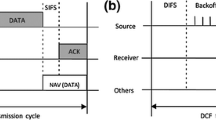Abstract
In this paper we propose a cooperative MAC protocol for Wireless Local Area Networks (WLAN) that involves the concept of cooperation among nodes to avoid the negative effect caused by multi rate modulation employed in IEEE 802.11 standards. In our proposed protocol a low data rate direct transmission link is replaced by two faster transmission links using a relay node. During transmission, each node selects either direct or indirect transmission (through a helper node) in order to minimize the total transmission time and utilizes the packet aggregation concept to improve the system throughput. The new protocol does not violate the inter frame space specified in IEEE 802.11 and shows compatibility with the standard. We give the mathematical analysis that shows that our proposed protocol increases the system throughput considerably in comparison to the existing ones. The analytical results are supported with the help of simulation. We have shown how this protocol can be implemented in combination with others to improve the system throughput in specific network scenarios.

















Similar content being viewed by others
References
Hung, F. Y., & Marsic, I. (2007). Effectiveness of physical and virtual carrier sensing in IEEE 802.11 wireless Ad Hoc networks. Wireless Communications and Networking Conference, Hong Kong (pp. 143–147), 11–15 March 2007.
Manshaei, M. H., & Turletti, T. (2003). Simulation based performance analysis of 802.11a wireless LAN. International Symposium on Telecommunication (IST 2003) Iran (pp. 758–762), August 16–18, 2003.
Kamerman, A., & Monteban, L. (1997). WLAN-II: A high performance wireless LAN for the unlicensed band. Bell Labs Technical Journals, summer 1997.
Holland, G., Vaidya, N., & Bahl, P. (2001). A rate-adaptive MAC protocol for multi-hop wireless networks. ACM MOBICOM 2001, Rome (pp. 236–251), July 16–21, 2001.
Zhu, H., & Cao, G. (2006). rDCF: A relay-enabled medium access control protocol for wireless Ad Hoc networks. IEEE Transactions on Mobile Computing, 5(9), 1201–1214.
Liu, P., Tao, Z., Narayanan, S., Korakis, T., & Panwar, S. S. (2007). CoopMAC: A cooperative MAC for wireless LANs. IEEE Journal on Selected Areas in Communications, 25(2), 340–354.
Duvvuru, M., & Datta, R. (2008). Persistence based cooperative MAC protocol for Ad Hoc wireless networks. IEEE Region 10 Conference (TENCON 2008), Hyderabad (pp. 1–6), 19–21 November 2008.
Yi, L., & Hong, J. (2007). A new cooperative communication MAC strategy for wireless Ad Hoc networks. 6th IEEE/ACIS International Conference on Computer and Information Science (ICIS 2007) Beijing (pp. 569–574), July 11–13, 2007.
Sai Shankar, N., Chun-Ting, C., & Ghosh, M. (2005). Cooperative communication MAC (CMAC)—A new MAC protocol for next generation wireless LANs. Wireless Networks, Communications and Mobile Computing, Maui, USA (Vol. 1, pp. 1–6), 13–16 June 2005.
Tan, K., Wan, Z., Zhu, H., & Andrian, J. (2007). CODE: Cooperative medium access for multi-rate wireless Ad Hoc network. 4th Annual IEEE Communications Society Conference on Sensor, Mesh and Ad Hoc Communications and Networks, (SECON ‘07) California, USA (pp. 1–10), 18–21 June 2007.
Zhou, B., Marshall, A., & Lee, T.-H. (2007). A k-round elimination contention scheme for WLANs. IEEE Transactions on Mobile Computing, 6, 11.
Bianchi, G. (2000). Performance analysis of the IEEE 802.11 distributed Coordination function. IEEE Journal of Selection Areas of Communications, 18, 535–547.
Cali, F., Conti, M., & Gregori, E. (1998). IEEE 802.11 wireless LAN: Capacity analysis and protocol enhancement. In Proceedings of the IEEE INFOCOM, San Francisco, USA, pp. 142–149, 29 March to 2 April 1998.
Author information
Authors and Affiliations
Corresponding author
Appendix 1: Mathematical analysis
Appendix 1: Mathematical analysis
The average packet transmission time (T 12) from a sender node in the 12 Mbps region is calculated as follows: The fraction of the average packet transmission time involving a helper node is given by,
\( where\, T_{CoopOH} = 2T_{PLCP} + 2T_{MAC} + T_{DIFS} + T_{RTS} + T_{HTS} + T_{ACK} + T_{HS} + 5T_{SIFS} . \)
In Eq. 16 \( L_{o\_H\_A} \) is additional overhead occurs in CoopMACA by the packet headers used in packet aggregation (Fig. 5). The first term corresponds to the overhead of the packet transmission using a helper node in CoopMACA and the remaining terms are the pay load transmission time in the first and second hop respectively.
In Eq. 17, the second term corresponds to the contribution from the event involving the collision of HTS frame. Here \( \overline{{H_{X,Y} }} \) is the probability of helper node selection failure due to the collision of HTS frame when the helper node is selected from the group (X, Y). The probability \( \overline{{H_{X,Y} }} \) is given by,
The term \( T_{CoopFH} \) is the over head time during the collision of HTS. \( T_{CoopFh} \) is given by
The term  is the transmission overhead occurs if there is no helper node exist to assist the transmission are given by,
is the transmission overhead occurs if there is no helper node exist to assist the transmission are given by,
The third term represents the effect of the events involving the packet transmission without any helper nodes.
Similarly we can find the average packet transmission time (T 6) when the sender node is in the 6 Mbps region.
1.1 Average packet transmission time
The average packet transmission time of a packet can be calculated by,
The first two terms in this expression analyses the effect of packet transmission in a single hop. The third term corresponds to the packet transmission time from the nodes at a data rate of 12 Mbps region that may result in the transmission of two packets (one from 12 Mbps node and the other from the helper node). The denominators of the third term include the probability transmitting an additional packet by aggregation and its effect in the average packet transmission time.
Rights and permissions
About this article
Cite this article
Jibukumar, M.G., Datta, R. & Biswas, P.K. CoopMACA: a cooperative MAC protocol using packet aggregation. Wireless Netw 16, 1865–1883 (2010). https://doi.org/10.1007/s11276-009-0232-8
Published:
Issue Date:
DOI: https://doi.org/10.1007/s11276-009-0232-8




